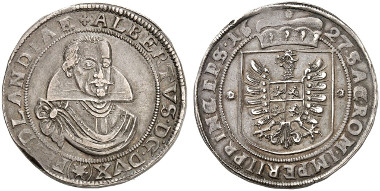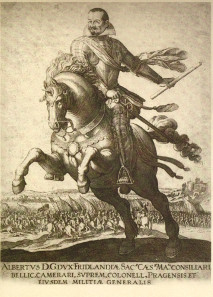Human faces, part 42: The Duke of Friedland
courtesy of the MoneyMuseum, Zurich
translated by Teresa Teklic
Why was the human head the motif on coins for centuries, no, for millennia? And why did that change in the last 200 years? Ursula Kampmann is looking for answers to these questions in her book “Menschengesichter” (“Human faces”), from which the texts in this series are taken.
Albrecht von Wallenstein, Duke of Friedland (1625-1634). Taler 1627, minted under the supervision of mint master Georg Reick, Jicin mint. Armoured bust of Wallenstein with military cloak and high collar, viewed from the front. R. Coat of arms crowned with ducal hat. © MoneyMuseum, Zurich.
At the outbreak of the Thirty Years’ War, Albrecht von Wallenstein served as a colonel in the Bohemian army. At the time the army was about to instate a new commander-in-chief. The estates were planning to exchange King Ferdinand II of Habsburg for the Elector Palatine of the Rhine.
Wallenstein was not willing to take part in this political about-face. He was Catholic, probably even a genuine believer. So he decided to stay loyal to his Catholic, rightfully elected commander.
In April 1619 he was presented with an opportunity to prove his loyalty. Wallenstein had been trusted with the Moravian war chest: 96,000 talers, an enormous sum that the emperor, who was constantly short of money, would have loved to call his own. For Wallenstein that was reason enough to convince his army of joining the Habsburg troops. He stabbed a sergeant who refused to cooperate, took the war chest and rode towards Vienna. No one could stop him now.
noneAt the outbreak of the Thirty Years’ War, Albrecht von Wallenstein served as a colonel in the Bohemian army. At the time the army was about to instate a new commander-in-chief. The estates were planning to exchange King Ferdinand II of Habsburg for the Elector Palatine of the Rhine.
Wallenstein was not willing to take part in this political about-face. He was Catholic, probably even a genuine believer. So he decided to stay loyal to his Catholic, rightfully elected commander.
In April 1619 he was presented with an opportunity to prove his loyalty. Wallenstein had been trusted with the Moravian war chest: 96,000 talers, an enormous sum that the emperor, who was constantly short of money, would have loved to call his own. For Wallenstein that was reason enough to convince his army of joining the Habsburg troops. He stabbed a sergeant who refused to cooperate, took the war chest and rode towards Vienna.
Wallenstein: Duke of Friedland, imperial treasurer and councillor of war, highest ranking colonel and general of Prague. Copperplate print, 1625/28. Source: Wikicommons.
The emperor welcomed Wallenstein with open arms. Good for Wallenstein, as he would not have been able to show his face in Bohemia for the time being. He only returned there once the uprising against Ferdinand had been put down. When he did, however, his big moment had come. In Prague, they were distributing the rebels’ lands at give-away prices: Ferdinand needed money for the war. And Wallenstein, who had married rich and was therefore in possession of enough cash, soon came into the possession of more than 50 estates.
That was a lot and, at the same time, it was not a lot. Other members of the gentry possessed an equal share of lands. Unlike his contemporaries though, Wallenstein saw the potential that his lands offered. He tried to increase productivity and established a taxation system that would guarantee maximum profit for him from the harvest. His strategy succeeded in a way that secured him a revenue much higher than that of the emperor.
In 1625 Wallenstein entered a new business: the war. He offered – and that was not news (see episode 31 “The Condottieri, winners in every war”) – the emperor to mobilise troops at his own cost and rent them out to the emperor. New was only the size of the army he had raised: 40,000 men. Wallenstein showed great talent in managing this army and generating financial profit from it. One thing he completely underestimated, however, was the fact that with his huge army he was not only a businessman but turning into a political power, which the emperor would have to eliminate sooner or later.
Something Wallenstein and Louis XIV had in common was their gift in handling money. More about the French ruler in our next episode.
You can find all episodes in the series here.
A German edition of the book “Menschengesichter” is available in print and as ebook on the site of the Conzett Verlag.










